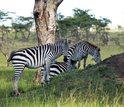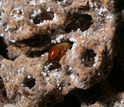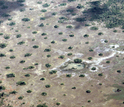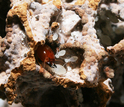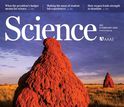News Release 15-010
Dirt mounds made by termites in Africa, South America, Asia could prevent spread of deserts
Termites create oases of moisture, plant life
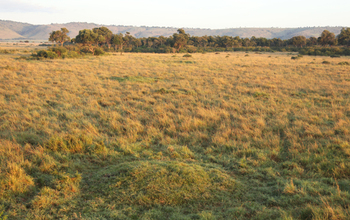
Termite mounds are nutrient hotspots in tropical grasslands and savannas, stabilizing ecosystems.
February 5, 2015
This material is available primarily for archival purposes. Telephone numbers or other contact information may be out of date; please see current contact information at media contacts.
Termites might not top the list of humanity's favorite insects, but new research suggests that their large dirt mounds are crucial to stopping deserts from spreading into semi-arid ecosystems.
The results indicate that termite mounds could make these areas more resilient to climate change.
The findings could also inspire a change in how scientists determine the possible effects of climate change on ecosystems.
In the parched grasslands and savannas, or drylands, of Africa, South America and Asia, termite mounds store nutrients and moisture and via internal tunnels, allow water to better penetrate the soil.
As a result, vegetation flourishes on and near termite mounds in ecosystems that are otherwise vulnerable to desertification.
Researchers report in this week's issue of the journal Science that termites slow the spread of deserts into drylands by providing a moist refuge for vegetation on and around their mounds.
Drylands with termite mounds can survive on significantly less rain than those without termite mounds.
Not all termites are pests
"This study demonstrates that termite mounds create important refugia for plants and help to protect vast landscapes in Africa from the effects of drought," said Doug Levey, program director in the National Science Foundation's Division of Environmental Biology, which funded the research.
"Clearly," said Levey, "not all termites are pests."
The research was inspired by the fungus-growing termite species, Odontotermes, but the results apply to all types of termites that increase resource availability on or around their mounds.
Corresponding author Corina Tarnita, a Princeton University ecologist and evolutionary biologist, said that termite mounds also preserve seeds and plant life, which helps surrounding areas rebound faster once rainfall resumes.
"Because termites allow water to penetrate the soil better, plants grow on or near the mounds as if there were more rain," said Tarnita. "The vegetation on and around termite mounds persists longer and declines slower.
"Even when you get to harsh conditions where vegetation disappears from the mounds, re-vegetation is still easier. As long as the mounds are there the ecosystem has a better chance to recover."
The stages of desertification: Where termites fit in
In grasslands and savannas, five stages mark the transition to desert, each having a distinct pattern of plant growth.
The researchers found that these plant growth patterns exist on a much smaller scale than previously thought. Overlaying them is the pattern of termite mounds covered by dense vegetation.
The termite-mound pattern, however, looks deceptively similar to the last and most critical of the five stages that mark the transition of drylands to desert.
Vegetation patterns that might be interpreted as the onset of desertification could mean the opposite: that plants are persevering thanks to termite mounds.
Termite mounds help grassland plants persevere
Robert Pringle, an ecologist and evolutionary biologist at Princeton and co-author of the paper, said that the unexpected function of termites in savannas and grasslands suggests that ants, prairie dogs, gophers and other mound-building creatures could also have important roles in ecosystem health.
"This phenomenon and these patterned landscape features are common," Pringle said.
"Exactly what each type of animal does for vegetation is hard to know in advance. You'd have to get into a system and determine what is building the mounds and what the properties of the mounds are.
"I like to think of termites as linchpins of the ecosystem in more than one way. They increase the productivity of the system, but they also make it more stable and more resilient."
Termites: Linchpins of the ecosystem
A mathematical model developed for the work determines how these linchpins affect plant growth.
The scientists applied tools from physics and mathematical and numerical analysis to understand a biological phenomenon, said paper first author Juan Bonachela of Strathclyde University in Scotland.
The model allowed the researchers to apply small-scale data to understand how rainfall influences vegetation growth and persistence in the presence and absence of termites across an entire ecosystem.
"Similar studies would be extremely challenging to perform in the field and would require very long-term experiments," Bonachela said.
"Models such as this allow us to study the system with almost no constraint of time or space and explore a wide range of environmental conditions with a level of detail that can't be attained in the field."
Additional support for the research was provided by a Princeton Environmental Institute Grand Challenges grant, the National Geographic Society, the Andrew W. Mellon Foundation and a John Templeton Foundation Foundational Questions in Evolutionary Biology grant.
-NSF-
-
Zebras graze the short grass growing atop a termite mound in Kenya.
Credit and Larger Version -
A termite soldier peeks out from a fungus-comb chamber that has been excavated from belowground.
Credit and Larger Version -
Termite mounds appear as patches of lush vegetation in a sparse landscape in Mozambique.
Credit and Larger Version -
Fungus-cultivating termites foster subterranean fungus gardens that support aboveground plants.
Credit and Larger Version -
The researchers' findings are described in the Feb. 6, 2015 issue of the journal Science.
Credit and Larger Version
Media Contacts
Cheryl Dybas, NSF, (703) 292-7734, email: cdybas@nsf.gov
Morgan Kelly, Princeton University, (609) 258-5729, email: mgnkelly@princeton.edu
Related Websites
NSF Grant: Causes and consequences of regular spatial patterning in foundation species: theoretical development and experimental tests in an African savanna: http://www.nsf.gov/awardsearch/showAward?AWD_ID=1355122&HistoricalAwards=false
The U.S. National Science Foundation propels the nation forward by advancing fundamental research in all fields of science and engineering. NSF supports research and people by providing facilities, instruments and funding to support their ingenuity and sustain the U.S. as a global leader in research and innovation. With a fiscal year 2023 budget of $9.5 billion, NSF funds reach all 50 states through grants to nearly 2,000 colleges, universities and institutions. Each year, NSF receives more than 40,000 competitive proposals and makes about 11,000 new awards. Those awards include support for cooperative research with industry, Arctic and Antarctic research and operations, and U.S. participation in international scientific efforts.
Connect with us online
NSF website: nsf.gov
NSF News: nsf.gov/news
For News Media: nsf.gov/news/newsroom
Statistics: nsf.gov/statistics/
Awards database: nsf.gov/awardsearch/
Follow us on social
Twitter: twitter.com/NSF
Facebook: facebook.com/US.NSF
Instagram: instagram.com/nsfgov

